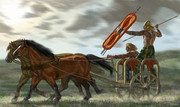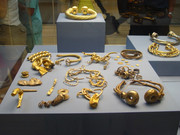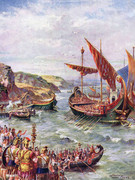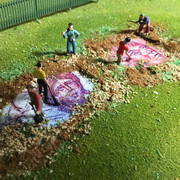The history of British Chariots: advice please
Chariot Inquiry: Grub, blood, and mud.
So my investigation into the history of British Chariots turned up some interesting dirt.
The rest of Europe had largely abandoned the use of Chariots. They were expensive and the casualty rate for drivers and bows men was undoubtedly high: think of modern day horse and rider circus acts- these guys had to be like high wire acts on rough terrain. Not good numbers.
But Britain persisted in using chariots for 300 years after the rest of Europe quit them. Romans continued their use in the games. Fun sport watching racers, horses, carts go ker-splat.

Takes me to Boudica.

Who in the Heck was Boudica? Funny you should ask that. The Romans, as they pressed westward in the British island were very heavy handed. They made the locals and offer they couldn't refuse: do it the Roman Way and pay your taxes/tribute to the emperor or die. Seems reasonable. The other Roman caveat was when you die, good tax payer or not, your entire estate goes to the Emperor, thank you, and you may starve now or go live with relatives, whatever, frankly, my dear, we don't give a damn. So. The Romans press westward through Wales, in pursuit of the Druids, who are really not going without a fuss. As they do, they have to march through territory of the the Iceni tribe of modern-day East Anglia, Britain. Initially, the Iceni's were fairly content to live in the round houses, tend thier goats and sheep, grow some barley, make thier beer, and pay off the Romans as long as the Roman's left them alone. But, alas, that was not the Roman way. We will get back to Boudica in a Roman minute.
The Iceni's did two things brilliantly: they made excellent iron swords and spears and they possessed impossibly advanced gold smith skills. They would take silver, copper, and gold and beat it for untold hours and hours into strands that were 20 feet in length and exceedingly thin. The pounding process caused the copper to shrink into the center and the silver and gold to meld giving an unusually lustrous sheen. Try doing that living off the grid. Here is an example of the end result, called a "Torque," as it was made from the twisting of the individual golden strands:

Now if that doesn't take your breath away, check your pulse. You will notice many are cut, this was done prior to burial, presumptively by the Icini's, as a ritual sacrifice, once the Romans made up their minds to eliminate the Incini's, but that is later in the story.
6. You may assume the Roman's loved gold and hated weaponry, especially sharp iron implements that could poke them. So as they pushed west in Wales, they demanded: a. give up all your property on death to the Emporer, b. give us all your weapons, c. and pay tribute with what is left over with gold, oh yeah, and feed us.
7. The last straw was the iron weapons. The Romans took them, bent them, broke them in half. To the Iron Age Incini (can you imagine the trial and error and time invested in smelting a good iron ore? That makes gold smithing look like patty cake) these weapons were handed down generationally and considered to have ancestral soul. It was an infamy to appropriate these things and destroy them, and damned if the Romans were going to fleece them of their golden Torques.

8. Boudica (AD 30 to 61) was the daughter of a local Icini Chieftan who passed on from natural causes. Before he died, he tried to appease the Roman constabulary by deeding over half his wealth. Gold, goats, you get the picture. The Romans said, "nope. When you die the estate goes to the Emperor, have a nice day." Then they sent out a large group to enforce the order, and for good measure gave Boudica a public whipping and sexually assaulted her three daughters, for good measure. Additionally, the oafish Romans liberally took slaves and generally made themselves utterly loathsome.
9. Well they underestimated Boudica, and she hopped on a chariot and rounded up 100,000 Celts and marched eastward to Londinium burning an pillaging every Roman settlement, outpost, and administrative complex she found, and descended on the hugely important Roman city and burned it to the ground as well. It is said Boudica's army killed about 70,000 Roman citizenry and British subjects that had adopted the Roman culture. I have no idea how she was able to round up 100,000 rural villagers and how the number of 70,000 was arrived at. What is known is that the Roman legions chasing down Druids in the West, and Roman legions chasing around Gaulic (French) upstarts were recalled at once to Britain and with their comparatively modern armies entrapped Boudica as she and her collection of rabble rousers traveled back west to their villages. Boudica, it is claimed, poisoned herself to evade capture.
url=https://postimg.cc/TydkVv3S] [/url]
[/url]
(Roman Legionairres piling into boats to chase down Boudica, leaving from Gaul (France).
10. At this juncture Torques and Icinian weapons, iron work, and pottery vanish from the archeological record. Rome continued to pour money and resources into trying to tame the British Isles. The Romans did not succeed in blending the British into the Roman culture as effectively as they did other conquered tribes, such as the Germans, French, and Egyptians. In the archeology record this is demonstrated by the regression of pottery designs from Romanesque back to plain British designs, the collapse of the iron industry- first slowly, then rapidly. Things like nails disappeared from hob nailed boots, then no more hinges and other iron implements. Roman dwellings, rather than being over taken for habitation were robbed of masonry which turns up in ancient churches and barns with Roman inscriptions quite legible. Poetry from the "Dark Ages" describes Roman columns and arches with a curiosity that bespeaks that the Roman tradition was not something the succeeding Brits had a communal interest in, at all. The archeological record shows that large tracts of Londinium were turned into field and pasture. Roman baths and intricate plumbing collapsed, burned, and eventually buried in yards of dirt.

Image of excavation of an extraordinary water lifting machine, quite likely used to transmit running water to a nearby
Roman bath house. A high rise was built over this monumental site. At least some of it got saved in the museum. By
analyzing the tree rings of the wood, it is dated precisely to 108 to 109 AD, about forty years after Boudica's onslaught. (Side note:
foobar. I recollect the arborologist identified the actual forest it came from, but I can't pull out that information without an extensive
Google search).
And to know all this barely touches the history of the UK leaves me, uh, gobsmacked, to borrow a phrase. And yes, I will look up that link, Ian,
thank you very much.

Roman mosaic excavation upon layout "Henley."
The rest of Europe had largely abandoned the use of Chariots. They were expensive and the casualty rate for drivers and bows men was undoubtedly high: think of modern day horse and rider circus acts- these guys had to be like high wire acts on rough terrain. Not good numbers.
But Britain persisted in using chariots for 300 years after the rest of Europe quit them. Romans continued their use in the games. Fun sport watching racers, horses, carts go ker-splat.


Takes me to Boudica.

Who in the Heck was Boudica? Funny you should ask that. The Romans, as they pressed westward in the British island were very heavy handed. They made the locals and offer they couldn't refuse: do it the Roman Way and pay your taxes/tribute to the emperor or die. Seems reasonable. The other Roman caveat was when you die, good tax payer or not, your entire estate goes to the Emperor, thank you, and you may starve now or go live with relatives, whatever, frankly, my dear, we don't give a damn. So. The Romans press westward through Wales, in pursuit of the Druids, who are really not going without a fuss. As they do, they have to march through territory of the the Iceni tribe of modern-day East Anglia, Britain. Initially, the Iceni's were fairly content to live in the round houses, tend thier goats and sheep, grow some barley, make thier beer, and pay off the Romans as long as the Roman's left them alone. But, alas, that was not the Roman way. We will get back to Boudica in a Roman minute.
The Iceni's did two things brilliantly: they made excellent iron swords and spears and they possessed impossibly advanced gold smith skills. They would take silver, copper, and gold and beat it for untold hours and hours into strands that were 20 feet in length and exceedingly thin. The pounding process caused the copper to shrink into the center and the silver and gold to meld giving an unusually lustrous sheen. Try doing that living off the grid. Here is an example of the end result, called a "Torque," as it was made from the twisting of the individual golden strands:

Now if that doesn't take your breath away, check your pulse. You will notice many are cut, this was done prior to burial, presumptively by the Icini's, as a ritual sacrifice, once the Romans made up their minds to eliminate the Incini's, but that is later in the story.
6. You may assume the Roman's loved gold and hated weaponry, especially sharp iron implements that could poke them. So as they pushed west in Wales, they demanded: a. give up all your property on death to the Emporer, b. give us all your weapons, c. and pay tribute with what is left over with gold, oh yeah, and feed us.
7. The last straw was the iron weapons. The Romans took them, bent them, broke them in half. To the Iron Age Incini (can you imagine the trial and error and time invested in smelting a good iron ore? That makes gold smithing look like patty cake) these weapons were handed down generationally and considered to have ancestral soul. It was an infamy to appropriate these things and destroy them, and damned if the Romans were going to fleece them of their golden Torques.

8. Boudica (AD 30 to 61) was the daughter of a local Icini Chieftan who passed on from natural causes. Before he died, he tried to appease the Roman constabulary by deeding over half his wealth. Gold, goats, you get the picture. The Romans said, "nope. When you die the estate goes to the Emperor, have a nice day." Then they sent out a large group to enforce the order, and for good measure gave Boudica a public whipping and sexually assaulted her three daughters, for good measure. Additionally, the oafish Romans liberally took slaves and generally made themselves utterly loathsome.
9. Well they underestimated Boudica, and she hopped on a chariot and rounded up 100,000 Celts and marched eastward to Londinium burning an pillaging every Roman settlement, outpost, and administrative complex she found, and descended on the hugely important Roman city and burned it to the ground as well. It is said Boudica's army killed about 70,000 Roman citizenry and British subjects that had adopted the Roman culture. I have no idea how she was able to round up 100,000 rural villagers and how the number of 70,000 was arrived at. What is known is that the Roman legions chasing down Druids in the West, and Roman legions chasing around Gaulic (French) upstarts were recalled at once to Britain and with their comparatively modern armies entrapped Boudica as she and her collection of rabble rousers traveled back west to their villages. Boudica, it is claimed, poisoned herself to evade capture.
url=https://postimg.cc/TydkVv3S]
 [/url]
[/url](Roman Legionairres piling into boats to chase down Boudica, leaving from Gaul (France).
10. At this juncture Torques and Icinian weapons, iron work, and pottery vanish from the archeological record. Rome continued to pour money and resources into trying to tame the British Isles. The Romans did not succeed in blending the British into the Roman culture as effectively as they did other conquered tribes, such as the Germans, French, and Egyptians. In the archeology record this is demonstrated by the regression of pottery designs from Romanesque back to plain British designs, the collapse of the iron industry- first slowly, then rapidly. Things like nails disappeared from hob nailed boots, then no more hinges and other iron implements. Roman dwellings, rather than being over taken for habitation were robbed of masonry which turns up in ancient churches and barns with Roman inscriptions quite legible. Poetry from the "Dark Ages" describes Roman columns and arches with a curiosity that bespeaks that the Roman tradition was not something the succeeding Brits had a communal interest in, at all. The archeological record shows that large tracts of Londinium were turned into field and pasture. Roman baths and intricate plumbing collapsed, burned, and eventually buried in yards of dirt.

Image of excavation of an extraordinary water lifting machine, quite likely used to transmit running water to a nearby
Roman bath house. A high rise was built over this monumental site. At least some of it got saved in the museum. By
analyzing the tree rings of the wood, it is dated precisely to 108 to 109 AD, about forty years after Boudica's onslaught. (Side note:
foobar. I recollect the arborologist identified the actual forest it came from, but I can't pull out that information without an extensive
Google search).
And to know all this barely touches the history of the UK leaves me, uh, gobsmacked, to borrow a phrase. And yes, I will look up that link, Ian,
thank you very much.

Roman mosaic excavation upon layout "Henley."
Who is online
Users browsing this forum: No registered users and 7 guests